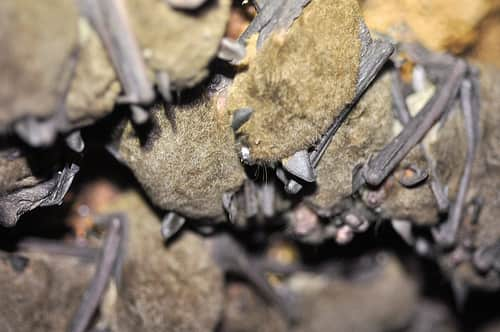White-nose Syndrome Confirmed in Federally Endangered Gray Bats
OutdoorHub 05.29.12

The U.S. Fish and Wildlife Service (Service) has confirmed the presence of white-nose syndrome in federally listed endangered gray bats (Myotis grisecens) in Hawkins and Montgomery counties in Tennessee.
White-nose syndrome (WNS) has decimated bat populations across eastern North America, with mortality rates reaching up to 100 percent at some sites. First documented in New York in 2006, the disease has spread into 19 states and four Canadian provinces. Bats with WNS may exhibit unusual behavior during cold winter months, including flying outside during the day and clustering near the entrances of caves and mines where they hibernate.
Bats have been found sick and dying in unprecedented numbers near these hibernacula.
This is the first confirmation of WNS in federally listed gray bats.
White-nose syndrome had previously been documented in six hibernating bat species, including the federally listed endangered Indiana bat (Myotis sodalis). Significant mortality has been documented in many colonies of hibernating Indiana bats in the Northeast and mid-Atlantic states. While no mortality has been observed in gray bats that can be linked to WNS, the confirmation that gray bats can be infected is cause for concern.
“The news that that another federally endangered bat species, the gray bat, has been confirmed with white-nose syndrome is devastating for anyone who cares about bats and the benefits they provide to people,” said Fish and Wildlife Service Director Dan Ashe. “Bats provide tremendous value to the U.S. economy as natural pest control for American farms and forests every year. Research and management of this disease remains a priority for the Service, and we will continue to work closely with our partners to understand the spread of this deadly disease and minimize its impacts to affected bat species.”
The gray bats were discovered on two separate winter surveillance trips, conducted by the Tennessee Wildlife Resources Agency (TWRA) and The Nature Conservancy (TNC). Biologists observed white fungus on the muzzles, wing, and tail membranes of several bats. Specimens were collected, and the disease was diagnosed by histopathology at the Southeastern Cooperative Wildlife Disease Study (SCWDS) at the University of Georgia, and later confirmed the USGS National Wildlife Health Center in Madison, Wisconsin.
“The documented spread of WNS on gray bats is devastating news. This species was well on the road to recovery, and confirmation of the disease is great cause for concern. Because gray bats hibernate together in colonies that number in the hundreds of thousands, WNS could expand exponentially across the range of the species,” said Paul McKenzie, Missouri Endangered Species Coordinator for the Service. “The confirmation of WNS in gray bats is also alarming because guano from the species is an important source of energy for many cave ecosystems and there are numerous cave-adapted species that could be adversely impacted by their loss.”
The gray bat, federally listed as an endangered species in 1976, occupies a limited geographic range in limestone karst areas of the southeastern United States. With rare exceptions, gray bats live in caves year-round.
Gray bats are endangered largely because of their habit of living in very large numbers in only a few caves, making them extremely vulnerable to disturbance. Cooperative conservation measures, such as restricting human access to critical gray bat hibernation and roosting sites, have been successful in helping gray bat populations recover in many areas.
The potential impact of white-nose syndrome on gray bats is still unknown.
Visible fungal growth was observed on hibernating gray bats in both sites, but no other definitive field signs of the disease or mortality events have been documented. The findings of these studies will be submitted to a peer-reviewed journal for publication, and gray bat roosts will continue to be monitored for any indication of deleterious impacts.
“We are not sure what this diagnosis is going to mean for gray bats and the spread of WNS,” said Jeremy Coleman, National WNS Coordinator for the Service. “Increased vigilance and improved diagnostic procedures may mean that we have identified the very early stages of infection in a new species. It is also possible that gray bats have been exposed for a few years, but do not succumb to the infection. Individual bat species appear to respond differently to WNS, and only research and time will reveal where gray bats fit on the spectrum.”

